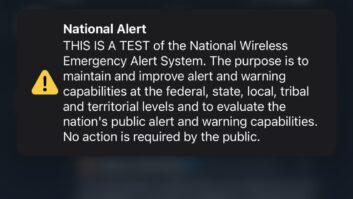
Ward Noland
With questions bouncing around about the implications for stations of the new CAP standard, Radio World is asking industry alerting leaders to provide their perspectives in a series of Q&As. Here, Radio World U.S. Editor in Chief Paul McLane talks to Ward Noland, state and local warning specialist for the state of Idaho.
RW: We understand that the Idaho Bureau of Homeland Security is supporting broadcasters in CAP compliance. What specifically is BHS doing, and what are you telling radio stations right now? How many stations are affected?
Noland: Attached is a letter (Word doc) that was sent out to all broadcasters that provide EAS services to the citizens of Idaho. We are providing CAP-compliant equipment to the broadcasters as a critical piece of the Idaho State Alert & Warning System (ISAWS) that is in development. It is estimated that we will provide equipment to approximately 70 radio and television broadcasters throughout the state.
RW: FEMA just recently approved CAP V1.2. How does this affect your program? How does the start of the FCC 180-day clock affect things?
Noland: The Idaho Bureau of Homeland Security has been proactive in our response to the changes that are taking place with public warnings. We were pleased with the direction that the FCC and FEMA had chosen for warnings, and excited by the idea that the EAS system was to be upgraded into a more robust system. The changes to the system allow for clear message delivery and the opportunity to deliver more information to more citizens quickly and effectively.
We do not foresee any negative impact to our program following FEMA’s adoption of CAP 1.2; in fact, software upgrades are all that will be required to upgrade our present CAP 1.1 system to CAP 1.2 compliance.
RW: Are you working with one or more specific hardware and alerting system vendors? Who?
Noland: We are working with MyState USA, Warning Systems Inc. (WSI) and Sage.
RW: Where in this process are you right now?
Noland: We are nearing the end of our pilot project to test the function of the ISAWS system, with rollout of the system statewide expected soon. We are in the process of accepting equipment requests from broadcasters now. The state EAS plan is being updated and prepared for submission to the FCC, with submission expected before Nov. 1, barring any unexpected complications.
RW: What technical information do you want/need to impart to radio station engineers?
Noland: We are asking broadcasters to complete an information form about their EAS equipment. The information obtained is used to program the unit(s) that will be sent to their station(s). We ask them to maintain a static IP address for the unit, and any technical issues are addressed on a case by case basis.
RW: What does this program cost the government and the broadcasters? Where does the state money come from?
Noland: There is no cost to the broadcasters other than the cost of obtaining and maintaining an Internet connection. The program budget for this year is approximately $170,000. Last year’s budget was lower than this year’s (approximately $130,000), but the yearly cost will decrease dramatically after all of the hardware has been purchased. The funding comes from Emergency Management Performance Grants (EMPG) and the Homeland Security Grant Program (HSGP), which are administrated and by the U.S. Department of Homeland Security (DHS) and FEMA.
RW: What else do you want radio stations in the state to know right now about this program specifically, or about alerting compliance in general?
Noland: The BHS is looking forward to continuing our working relationship with the broadcast community that serves the citizens of Idaho. CAP and ISAWS present new opportunities to improve emergency notification delivery, and we look forward to the full rollout of our system and welcome any questions or comments that our broadcast partners may have.
Related:
“Alerting Q&A: Harold Price” (Oct. 12, 2010)
“Fowlkes Answers Alerting Questions” (Oct. 7, 2010)












